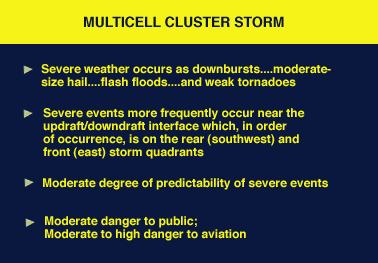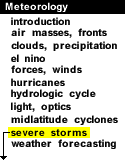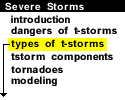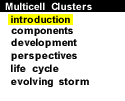
|
A multicell cluster consists of a group of cells moving as a single unit, with each cell in a different stage of the thunderstorm life cycle. As the multicell cluster evolves, individual cells take turns at being the most dominant. New cells tend to form along the upwind (typically western or southwestern) edge of the cluster, with mature cells located at the center and dissipating cells found along the downwind (east or northeast) portion of the cluster.
Multicell cluster storms frequently look similar to the one pictured in the photograph below, (assuming that low visibilities and/or intervening clouds, trees, or hills do not obscure the view). Looking north from about 10 miles, note the three distinct updraft towers at the left (west) portion of the storm. The heaviest precipitation likely falls beneath the highest cloud top. The right (east) side of the complex is dominated by anvil outflow, moving with the storm from left to right.

Photograph by: Moller
Multicell severe weather can be of any variety, and generally these storms are more potent than single cell storms, but considerably less so than supercells. Organized multicell storms have the higher severe weather potential, although unorganized multicells, which are simply conglomerates of single cells, can produce pulse storm-like bursts of severe events.

Actually, the distinction between multicell and single cell storms is not nearly as important as that between multicells and supercells. The multicell flash flood threat can be significant, in fact most flash floods probably occur with multicell complexes. As with all thunderstorms, the threat to the aviation community is quite high.

Single Cell Storms |
|

components |





